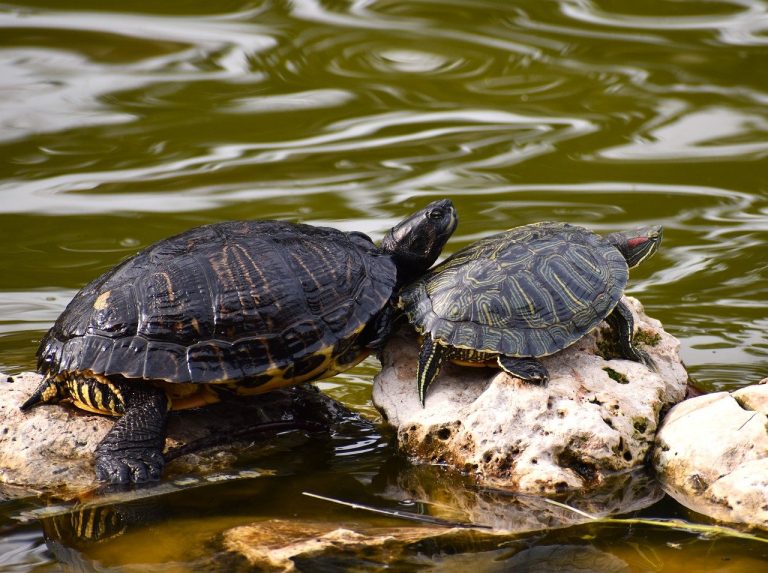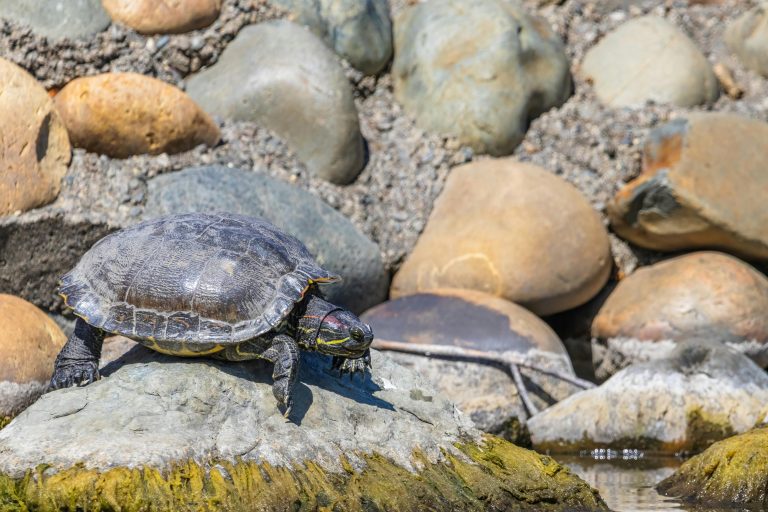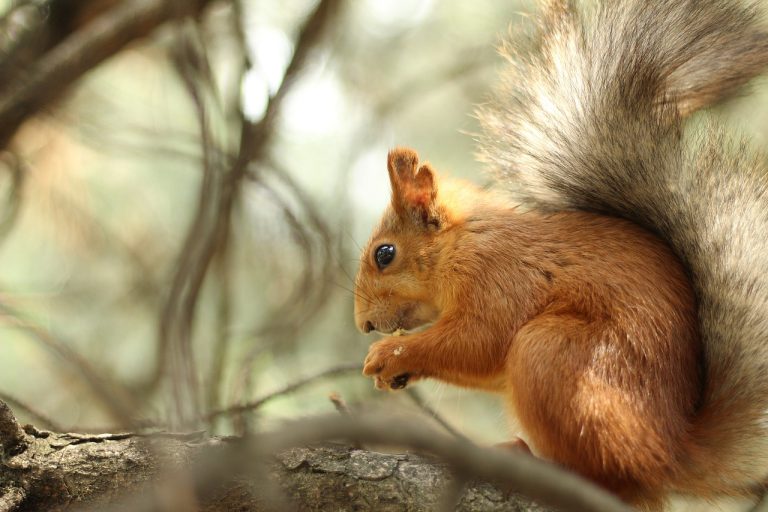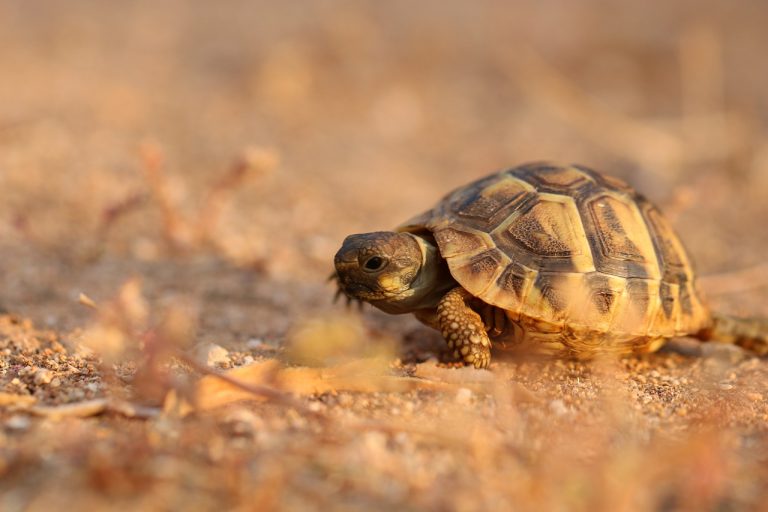Musk Turtle Size: How Big Do They Get?
Ever wondered why musk turtles boast such a dedicated fan base? Is it their adorable appearance or gentle demeanor? Well, those factors may contribute, but the real allure lies in their petite size, making handling a breeze. So, just how large do musk turtles actually grow?
Common musk turtles typically measure between 2 to 5.5 inches (5.1 to 14 centimeters) in length on average. However, some individuals can reach up to 7 inches or 18 centimeters.
To ensure optimal growth, musk turtles require meticulous care. In the forthcoming article, not only will I outline the size chart for musk turtles, but I’ll also delve into the key factors that can unlock their growth potential. Stay tuned to discover what your musk turtle may need to achieve its desired size.

How Big Do Musk Turtles Get?
The common musk turtle, also known as the Eastern musk turtle or Stinkpot, holds the title as the most recognized subspecies of musk turtle. Nevertheless, this species encompasses other subspecies, each with its own distinctive traits.
Musk turtles, across their various subspecies, exhibit a wide range of sizes. On average, these turtles grow anywhere from 2 to 15 inches in length. For a more comprehensive understanding of musk turtle growth, refer to the chart below for detailed information.
| Musk Turtle Subspecies | Average Size | Additional Information |
|---|---|---|
| Common Musk Turtle/ Eastern Musk Turtle/ Stinkpot | 2 to 5.5 inches (5.1 to 14 inches) | Common musk turtles are tiny and can be born about one inch or less. An adult stinkpot gets around 2 to 5.5 inches big. However, most turtles manage to have a carapace length of 7 inches (18 centimeters). Common musk turtle hatchlings are considered the smallest among all North American turtles. Surprisingly, the baby might fit onto your penny. |
| Mexican Giant Musk Turtle/ Mexican Musk Turtle/ Narrow Bridged Musk Turtle/ | 14 to 15 Inches (36 to 38 centimeters) | Mexican musk turtles have the largest carapace among all other musk turtle subspecies. These turtles are native to Mexico, Belize, Honduras, and Guatemala. Instead of the tag giant, the Mexican musk turtles are easy to handle. The subspecies make a great pet, and you will have to spend at least $700 to get a large giant musk turtle. The interesting part about Mexican giant musk turtles is they are born around 1.5 inches. It means these turtles experience a 10x growth over their lifetime. |
| Chiapas Giant Musk Turtle | 6 to 7 inches (15 to 18 centimeters) | Chiapas giant musk turtles are the smaller of the two giant subspecies. The hatchlings are around 1.5 to 2 inches when born. Most adult Chiapas giant musk turtles grow to be 6 to 7 inches (15 to 18 centimeters) big. The largest Chiapas musk turtle ever recorded has a carapace length of 10 inches (25.5 centimeters). Chiapas giant musk turtles are not very expensive and make excellent pets. With proper housing, diet, and care, most of these turtles can enjoy healthy growth. |
| Stripe Neck Musk Turtle | 3 to 4 inches (7.5 to 10 centimeters) | Stripe neck musk turtles are a subspecies of loggerhead musk turtle. The keeled carapace with tanned brown or gray gives this subspecies a unique appearance. Stripe neck musk turtles are small, with most adults reaching a healthy growth of 3 to 4 inches. However, there are records of stripe neck musk turtles having a carapace length of 4.5 to 4.6 inches. Experts claim that this subspecies can grow up to 5 inches. |
| Razorback Musk Turtle | 5 to 6 inches (12 to 15 centimeters) | Razorback musk turtles are characterized by the razor-sharp keels on their central carapace. A newborn razorback musk turtle is around 0.9 to 1.1 inches and weighs not more than 5 grams. These babies grow into 5 to 6 inches in adulthood. With the best care, razorback musk turtles can reach a carapace length of 7 inches (17.6 centimeters). |
| Loggerhead Musk Turtle | 3 to 6 inches (7.6 to 15 centimeters) | Loggerhead musk turtles are relatively smaller than most other musk turtle species. Generally, the babies are born with a carapace of 1.1 inches or less. Loggerhead musk turtles exhibit sexual dimorphism, with males being slightly shorter than females. |
| Flattened Musk Turtle | 3 to 4 inches (7.6 to 10 centimeters) | Flattened musk turtles are born small, at about 1 inch in length. In adulthood, these turtles grow to have a carapace length of 2.4 to 5 inches. |
Factors Affecting The Growth Of A Musk Turtle
Have you ever observed that two musk turtles of the same age can grow into different sizes? What’s the secret behind this variation? Well, several factors influence a musk turtle’s growth and development, including:
Subspecies
The variation in size among musk turtles becomes evident when comparing different subspecies. For instance, while a common musk turtle typically measures between 2 to 5.5 inches, a Mexican giant musk turtle can reach an impressive 15 inches.
Gender
Musk turtles display sexual dimorphism, meaning there are observable differences in size and body structure between males and females. In some subspecies, males may grow larger, but generally, females have larger carapaces than males, as seen in the loggerhead musk turtle.
Determining the gender of a musk turtle can be accomplished by observing characteristics such as tail thickness or length, as well as variations in the coloration of the head, eyes, or skin.
Genetics
Genetics play a crucial role in determining the size of a musk turtle. Some turtles may not reach average carapace lengths due to hereditary factors.
Pet or Wild
Pet musk turtles are typically larger than their wild counterparts due to receiving consistent care and nutrition. However, this may not always be the case, as pet turtles may not achieve expected growth if they lack proper diet or housing conditions.
Housing Arrangements
The living conditions of musk turtles significantly impact their growth and carapace length. A cramped enclosure with inadequate equipment and dirty water can stress out the turtle, leading to stunted growth. Proper habitat setup, including access to UV light, is essential for healthy growth and development.
Diet
A balanced diet is crucial for the growth of musk turtles, especially during their vulnerable early stages. Vitamin and mineral deficiencies resulting from an inadequate diet can impede growth. Overfeeding can also lead to health issues such as liver failure or kidney stones.
Health
Musk turtles are susceptible to various diseases, including bacterial infections, respiratory illnesses, and shell rot. Severe illnesses can shorten the turtle’s lifespan and hinder healthy growth. Regular veterinary care and attentive monitoring of the turtle’s health are essential for promoting optimal growth and well-being.
How Big Is A Fully Grown Musk Turtle?
A fully grown musk turtle can range from 2 to 15 inches in size, depending on the subspecies. Typically, musk turtles experience rapid growth during their first year, with growth slowing down thereafter. Most musk turtles cease growing once they reach sexual maturity.
For example, common musk turtles hatch with a carapace length of less than 1 inch. Within six months, they can grow to about 2 inches. By the end of their first year, many common musk turtles exhibit rapid growth, reaching lengths of 3 to 5 inches. By the time they reach two years old, their carapace length can range from 6 to 7 inches.
However, not all common musk turtles follow the same growth pattern, as various factors can influence their development.
Regarding gender differences, female musk turtles are generally larger than males. While the size distinction may not always be obvious, experts suggest that males are typically at least 1 inch shorter than females. However, in some subspecies, males may be slightly larger than females.
When evaluating the gender of a musk turtle, it’s essential to consider other sex-specific characteristics. For instance, male musk turtles may have rough, scaly patches on their rear legs, while their tails are often longer and thicker compared to females.
How To Ensure The Healthy Growth Of A Musk Turtle?
Ensuring the healthy growth of your pet musk turtle hinges on following a comprehensive care regimen. Here are some tips to aid in this endeavor:
- Don’t be deceived by their small size; even common musk turtles require ample space. A 20 to 30-gallon aquarium should suffice for an adult stinkpot, though larger tanks may be necessary for multiple turtles or different musk turtle species.
- Proper housing arrangements are vital for disease prevention and promoting optimal growth. Essential equipment includes a basking dock, water filter, tank heater, heating lamp, and UV light.
- As omnivores, musk turtles benefit from a varied diet comprising snails, small fish, insects, worms, kale, collard greens, and other leafy vegetables. Be sure to sprinkle calcium and vitamin D3 supplements onto each meal to support healthy growth and prolong their lifespan.
- Vigilance against diseases is crucial for unhindered growth. Promptly seek veterinary attention if your musk turtle falls ill, and schedule annual health check-ups with a reptile expert.
- Despite your best efforts, don’t anticipate uniform growth in all musk turtles. Genetic factors can significantly influence their size, even with optimal care.
- If you notice any signs of stunted growth or health issues, seek professional advice. As long as your musk turtle maintains a healthy appetite, there’s likely no cause for alarm. Additionally, keep in mind that musk turtles may exhibit slow carapace development, which can be challenging to detect.
Before You Go…
The size of a musk turtle can vary significantly, ranging from 2 to 15 inches. However, achieving optimal growth depends on various factors. When kept in captivity, providing the turtle with excellent care is paramount, as this greatly influences its development. With proper diet and suitable housing conditions, a musk turtle typically reaches its full growth potential.



![How Do Sea Turtles Mate? [FAQs Answered]](https://spreadhapiness.com/wp-content/uploads/2024/03/mate-1-768x576.jpg)

![21 DIY Turtle Tank Ideas For Happy Turtles [Budget-Friendly]](https://spreadhapiness.com/wp-content/uploads/2024/03/turtle-tank-3-768x576.jpg)